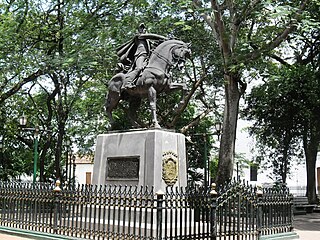Related Research Articles

The Orinoco is one of the longest rivers in South America at 2,250 kilometres (1,400 mi). Its drainage basin, sometimes known as the Orinoquia, covers 989,000 km2 (382,000 sq mi), with 76.3 percent of it in Venezuela and the remainder in Colombia. It is the fourth largest river in the world by discharge volume of water. The Orinoco River and its tributaries are the major transportation system for eastern and interior Venezuela and the Llanos of Colombia. The environment and wildlife in the Orinoco's basin are extremely diverse.

The St. Croix River is a river in northeastern North America, 71 miles (114 km) in length, that forms part of the Canada–United States border between Maine (U.S.) and New Brunswick (Canada). The river rises in the Chiputneticook Lakes and flows south and southeast, between Calais and St. Stephen. It discharges into Passamaquoddy Bay, in the Bay of Fundy.

Apure State is one of the 23 states (estados) into which Venezuela is divided. Its territory formed part of the provinces of Mérida, Maracaibo, and Barinas, in accordance with successive territorial ordinations pronounced by the colonial authorities. In 1824 the Department of Apure was created, under jurisdiction of Barinas, which laid the foundations for the current entity. In 1856 it separated from Barinas and for the first time Apure appeared as an independent province, which in 1864 acquired the status of state. In 1881, however, a new territorial division combined Apure and Guayana to form a single state named Bolívar. In 1899 it reestablished its autonomy and finally, by means of the Constitution of 1909, gained its current borders.

Villa de Todos los Santos de Calabozo is an inland town of Venezuela, once capital of the Province of Caracas in the colonial period, formerly in the State of Miranda and former capital of the state of Guárico.

Guárico River is a river in Venezuela.
Huautla is a small town in the Mexican state of Morelos, in the municipality of Tlaquiltenango. Revolutionary General Gildardo Magaña Cerda (1891-1939) was proclaimed successor of Emiliano Zapata to the leadership of the Liberation Army of the South near this town on 1919-09-04.

Rowing at the 1928 Summer Olympics featured seven events, for men only. The competitions were held from 2 to 10 August.

San Fernando de Atabapo is a town in southern Venezuela on the border with Colombia. It was the capital city of the Amazonas state until the early 1900s. The population in 1997 was approximately 5,000.

Capanaparo River is a river of Colombia and Venezuela. It is part of the Orinoco River basin. In Venezuela together with the Cinaruco River, other smaller rivers and the area around them they form the Santos Luzardo National Park since 1988.

Cinaruco River is a river of Colombia and Venezuela. It is part of the Orinoco River basin. It has partially clear tanic waters. In Venezuela this river is part of the Santos Luzardo National Park since the year 1988. The Cinaruco River together with the Capanaparo River, other smaller rivers and the area around them form this national park. It houses a big biodiversity and many fishermen go each year looking for peacock bass. Three different species of peacock bass are found in this river: Cichla intermedia, Cichla orinocensis and Cichla temensis from smallest to biggest.

The Inírida is a river in the north-west of South America, in the territory of Colombia, the largest tributary of the Guaviare.
The Portuguesa River is a river of Venezuela. It is part of the Orinoco River basin, and is a tributary of the Apure River.
The Caño Central is a river of Venezuela. It drains into Lake Valencia.
Parguaza River is a river of Venezuela. It is part of the Orinoco River basin.
Sipapo River is a river of Venezuela. It is part of the Orinoco River basin.
Cuao River is a river of Venezuela. It is part of the Orinoco River basin.
The Autana River is a blackwater river of Venezuela, a tributary of the Sipapo River in the middle Orinoco River basin.
Benton Township is an inactive township in Howell County, in the U.S. state of Missouri.

The Baré, or Hanera, and Werekena are related indigenous people of northwest Brazil and Venezuela. For many years they suffered from violent exploitation by Portuguese and Spanish merchants, forced to work as debt slaves. They moved often to try to avoid the merchants. Today most live by agriculture, hunting, fishing and gathering, and extract piassava fiber for income to buy goods from traders.
References
- Rand McNally, The New International Atlas, 1993.
Coordinates: 6°47′39″N67°01′29″W / 6.7942°N 67.0247°W